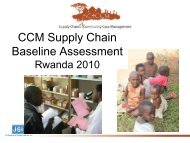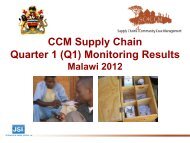The Power of Theories of Change By Paul Brest
The Power of Theories of Change By Paul Brest - SC4CCM
The Power of Theories of Change By Paul Brest - SC4CCM
- No tags were found...
You also want an ePaper? Increase the reach of your titles
YUMPU automatically turns print PDFs into web optimized ePapers that Google loves.
to the assessment <strong>of</strong> theories <strong>of</strong> change and the actual impact <strong>of</strong> social<br />
interventions. A developmental approach is premised on the following<br />
observations about theories <strong>of</strong> change.<br />
■■<br />
■■<br />
■■<br />
■■<br />
Both funders and grantee organizations ultimately care about<br />
actual impact and not theories, but impact is <strong>of</strong>ten difficult to<br />
measure. <strong>The</strong>refore, they must sometimes rely on beliefs about<br />
the soundness <strong>of</strong> a theory <strong>of</strong> change that underlies an organization’s<br />
strategy as a predictor <strong>of</strong> its future impact.<br />
<strong>The</strong>ories <strong>of</strong> change are drawn from the fields (such as education<br />
and health) in which both funders and their grantees operate.<br />
<strong>The</strong> theories <strong>of</strong> change available to a field are not static but<br />
rather evolve as a field matures, proving themselves to be valid<br />
(or not).<br />
Funders’ and grantees’ intuitions about theories <strong>of</strong> change <strong>of</strong>ten<br />
play an important role at the very early stages <strong>of</strong> an organization’s<br />
or field’s development. But over time, a theory <strong>of</strong><br />
change must be subjected to empirical validation and, eventually,<br />
to demonstration <strong>of</strong> actual impact.<br />
Before going into more detail on the developmental approach to<br />
theories <strong>of</strong> change, it is important to better understand the views <strong>of</strong><br />
those who argue that funders should not concern themselves with<br />
theories <strong>of</strong> change. (See “Defining Terms” on page 49 for further<br />
explanation <strong>of</strong> theory <strong>of</strong> change and related terms.)<br />
Radical Skeptics and Agnostics<br />
Critics <strong>of</strong> strategic philanthropy can be grouped into two points<br />
<strong>of</strong> view, which I call radical skepticism and theory-<strong>of</strong>-change<br />
agnosticism.<br />
William Schambra and Bill Somerville—from conservative and<br />
progressive positions, respectively—are radical skeptics not only<br />
about theories <strong>of</strong> change but also about the possibilities <strong>of</strong> evaluating<br />
impact. Schambra, formerly the director <strong>of</strong> programs at the Lynde<br />
and Harry Bradley Foundation, now directs the Hudson Institute’s<br />
Bradley Center for Philanthropy and Civic Renewal. Somerville, formerly<br />
the executive director <strong>of</strong> the Peninsula Community Foundation,<br />
now runs the Philanthropic Ventures Foundation.<br />
Schambra and Somerville argue that funders should focus their<br />
grantmaking on community-based organizations, and that funders<br />
should trust an organization’s leaders without requiring them to articulate<br />
theories <strong>of</strong> change or imposing formal evaluation processes.<br />
Schambra’s position is rooted in a conservative skepticism about<br />
the possibilities <strong>of</strong> broad social change; Somerville’s position comes<br />
from a distrust <strong>of</strong> pr<strong>of</strong>essional foundation staff and a strong belief<br />
in his own intuitive ability to pick good organizations.<br />
<strong>The</strong>se skeptics are implicitly analogizing grantees to idiots savants—individuals<br />
who are able to do complex calculations, such<br />
as finding the square root <strong>of</strong> any number, in their heads without<br />
knowing, let alone being able to explain, how they do it. Somerville’s<br />
<strong>Paul</strong> <strong>Brest</strong> is president <strong>of</strong> <strong>The</strong> William and Flora Hewlett Foundation. Before<br />
joining the Hewlett Foundation, he was a pr<strong>of</strong>essor at Stanford Law School, serving<br />
as dean from 1987 to 1999. He is coauthor <strong>of</strong> the book Money Well Spent: A Strategic<br />
Plan for Smart Philanthropy. He is also coauthor <strong>of</strong> “Calculated Impact” (Stanford<br />
Social Innovation Review, winter 2009) and author <strong>of</strong> “Smart Money: Strategic<br />
General Operating Support” (Stanford Social Innovation Review, winter 2003).<br />
writings imply that even if his grantees could explain their strategies,<br />
they are so busy doing good that it would be wicked to make<br />
them take the time to do so.<br />
If there are social entrepreneurs who can demonstrate their impact<br />
without a strategy, or who can pursue a successful strategy without<br />
any articulable theory <strong>of</strong> change, all the more power to them. But<br />
this strikes me as highly unlikely. Achieving social change is much<br />
harder than doing square roots. And knowing whether one is actually<br />
achieving impact adds a further complexity. When the savant tells<br />
you that the square root <strong>of</strong> 7 is 2.645, you can check his result on a<br />
calculator. It’s a lot harder to verify whether a community youth organization<br />
is having a positive impact on the lives <strong>of</strong> disadvantaged<br />
kids. <strong>The</strong>refore, both the organization and its funders must <strong>of</strong>ten<br />
rely—at least in the short or medium term—on the plausibility <strong>of</strong><br />
its theory <strong>of</strong> change as a proxy for impact.<br />
Indeed, most evaluations <strong>of</strong> social interventions require understanding<br />
the theories that mediate between inputs, activities, and<br />
outcomes. 3 <strong>The</strong>ory-based evaluation requires understanding the<br />
steps embedded in a logic model <strong>of</strong> how an organization’s activities<br />
lead to impact. Even when the outcomes <strong>of</strong> social interventions can<br />
be evaluated through rigorous studies, the evaluators must know<br />
what variable to examine. Identifying the proper variables and metrics<br />
requires that one articulate the program’s goals and its underlying<br />
theory <strong>of</strong> change. 4<br />
<strong>The</strong> second group <strong>of</strong> critics, exemplified by Stannard-Stockton,<br />
is what I call theory-<strong>of</strong>-change agnostics. <strong>The</strong>y believe that it is difficult<br />
to create a meaningful theory <strong>of</strong> change because social problems<br />
are complex and ever changing. Rather than spending time and<br />
money trying to craft or assess theories <strong>of</strong> change, agnostics think<br />
it is more productive for funders and grantees to focus instead on<br />
building great organizations.<br />
Jeff Berndt, a partner in the venture philanthropy fund New<br />
Pr<strong>of</strong>it, is also an agnostic. He writes: “We see our role as a funder<br />
as identifying the best solutions to social problems, then providing<br />
these solutions with the financial and strategic support needed to<br />
grow their social impact. At New Pr<strong>of</strong>it we’ve decided not to become<br />
subject matter experts. We don’t subscribe to any one point <strong>of</strong> view<br />
on education reform, health-care efficiencies, or workforce development<br />
strategies. Instead, we believe entrepreneurs hold the insights<br />
and are best suited to design and grow their innovations.” 5<br />
Stannard-Stockton and Berndt believe that a funder should be<br />
concerned with the organization rather than the theory <strong>of</strong> change<br />
underlying its work. But the two are not mutually exclusive. If the<br />
organization is the horse and the theory <strong>of</strong> change the carriage, then<br />
as Frank Sinatra famously sang, you can’t have one without the other.<br />
Both are necessary to get passengers—whether disadvantaged youth<br />
living in the United States or people living on less than $2 a day in<br />
India—to their intended destination.<br />
Kristi Kimball, a program <strong>of</strong>ficer in <strong>The</strong> William and Flora<br />
Hewlett Foundation’s Education Program, approaches the issue<br />
from a perspective different from Stannard-Stockton and Berndt’s,<br />
but she ends up with a quite similar funding strategy. She argues<br />
that a funder should adopt a widely pluralistic approach in order<br />
to promote innovation. For example, there are numerous promising<br />
ways to improve K-12 student outcomes, including supporting<br />
48 Stanford Social Innovation Review • Spring 2010






